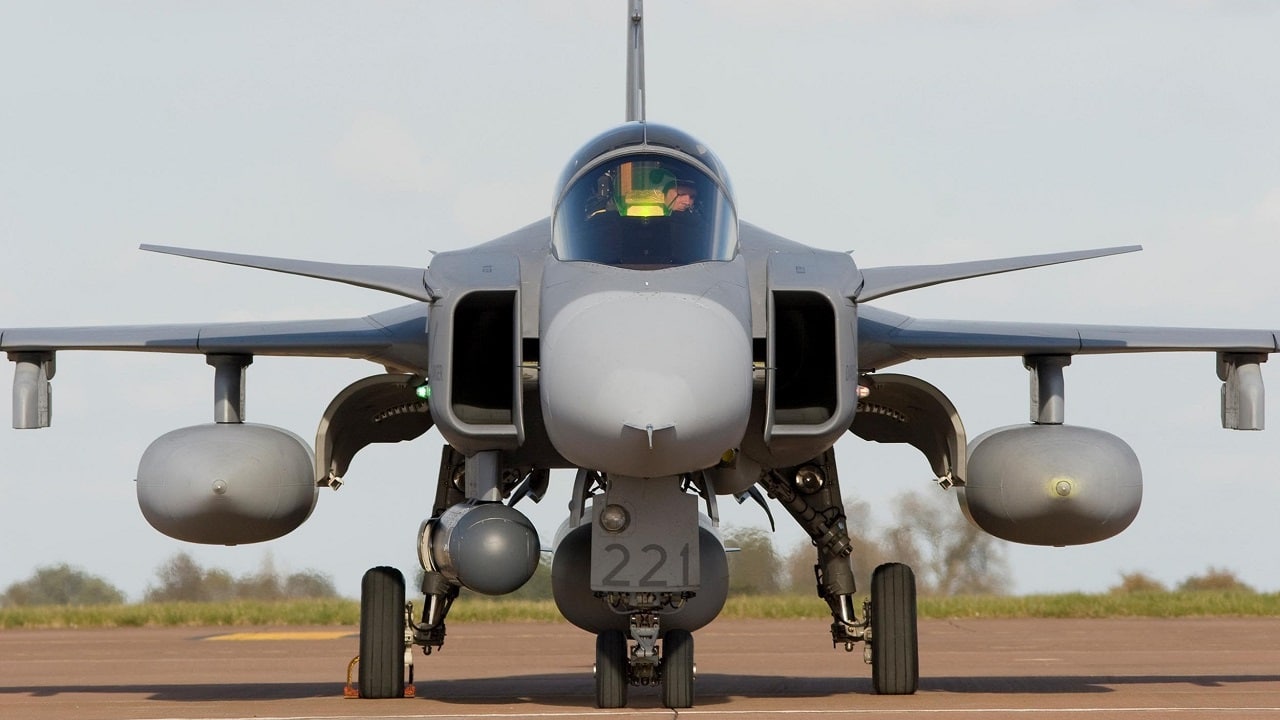Key Points: The Saab JAS 39 Gripen is more than Sweden’s multi-role fighter; it embodies the nation’s defense strategy focused on resilience against Russia.
-Central to the Bas 90 concept, it operates from dispersed road bases, requiring minimal ground support. Uniquely, it’s designed for rapid servicing (refuel, rearm) by conscripts with basic training, thanks to its low-maintenance design and robust engine.

JAS 39 from Sweden. Image Credit: Creative Commons.
-The latest Gripen E variant boasts advanced multi-role capabilities with modern weapons like Meteor and IRIS-T missiles.
-While not a stealth fighter, its cost-effectiveness, reliability, and minimal logistical needs make it highly competitive internationally.
Saab’s JAS 39 Fighter Is a Beast
The Saab JAS 39 Gripen is Sweden’s frontline multi-role fighter — but it is also much more than that; it is a reflection of the threat on Sweden’s doorstep: the Soviet Union during the Cold War and Russia today.
The Gripen is the centerpiece of Sweden’s Bas 90 air basing system that eschews large, centralized air bases in favor of small groups of aircraft dispersed throughout Sweden.
JAS 39 Can Do Amazing Things
Bas 90 is the Swedish brainchild of lessons learned from the 1967 Six-Day War, in which the Israeli Air Force destroyed virtually the entire Egyptian fleet of aircraft, as well as dozens of other aircraft in other Arab countries.
Bas 90 mitigates the risk of wipe-out by its network of small, austere air bases across the country. At these dispersed locations, Gripens can leverage public roads to land and take off, needing just a 500-meter strip of pavement to do so. A good thrust-to-weight ratio, robust landing gear, and flight control systems aid this objective.
But beyond just the aircraft itself, the Gripen is also an essential piece of Sweden’s defense architecture more broadly, which relies heavily on conscription to fill its ranks. Unlike more advanced and, indeed, much more capable aircraft like the F-35, the Gripen was explicitly designed for rapid servicing by young conscripts without much training or specialized experience.
Conscripts can rearm, refuel, and repair basic issues without robust air base infrastructure, allowing Gripens a very rapid turnaround time from landing to take-off.
The Gripen’s rapid turnaround time is made possible thanks to its very low maintenance design. The Gripen engine, Volvo’s Reaktionsmotor 12, is a license-built turbofan engine that is modified from the General Electric F404. It is more robust and better resists bird strikes or foreign object ingestion.

A Swedish JAS-39 Gripen returns to the play areas of the Arctic Challenge exercise Sept. 24, 2013, over Norway, after taking on fuel from a U.S. Air Force KC-135R Stratotanker. The JAS-39, in coordination with aircraft from other nations, formed a Blue assault force, which had to bypass or neutralize an opposing Red force attempting to stop them from an overall objective outlined in the day’s scenario. (U.S. Air Force photo by 1st Lt. Christopher Mesnard/Released)
JAS 39 Gripen E
The latest iteration of the Gripen design is the Gripen E. Saab explains that the Gripen E has 10 hard points, offers the best in class weapons and pods from around the world; and has an unrivaled ease of stores integration.”
It goes on to explain that the Gripen E can “conduct air-to-air, air-to-surface and reconnaissance missions. Air supremacy is achieved with the carriage of up to seven Meteor Beyond Visual Range Air-to-Air Missiles and two Within Visual Range IRIS-T missiles. Weapons like these, combined with the ability to use offensive and defensive means simultaneously, enables Gripen E to detect, engage and suppress or destroy targets effectively.”
Though Sweden does not operate any aircraft carriers, it does offer a navailized variant of the jet that can operate from aircraft carriers in CATOBAR and STOBAR configurations. The engine is also marinized for operation in high-humidity environments and can resist salt ingestion from seawater.
Success Abroad
The solid Swedish design is reflected in the diverse and numerous countries that have accepted the jet into service either as a fighter or trainer jet: Brazil, the Czech Republic, Hungary, South Africa, Sweden, Thailand, and the United Kingdom. Saab’s design offers an affordable balance of performance, reliability, and flexibility at an attractive price point.
Although newer, fifth-generation aircraft vastly outclass the Gripen in terms of speed and range, the Gripen remains unrivaled compared to fourth-generation aircraft, especially in terms of operating costs, maintenance requirements, and minimal logistical footprint.
Sweden’s defensive doctrine, which centers around resilience and survivability, is what the Gripen caters to — and will likely do so for years to come.
About the Author: Caleb Larson
Caleb Larson is an American multiformat journalist based in Berlin, Germany. His work covers the intersection of conflict and society, focusing on American foreign policy and European security. He has reported from Germany, Russia, and the United States. Most recently, he covered the war in Ukraine, reporting extensively on the war’s shifting battle lines from Donbas and writing on the war’s civilian and humanitarian toll. Previously, he worked as a Defense Reporter for POLITICO Europe. You can follow his latest work on X.

